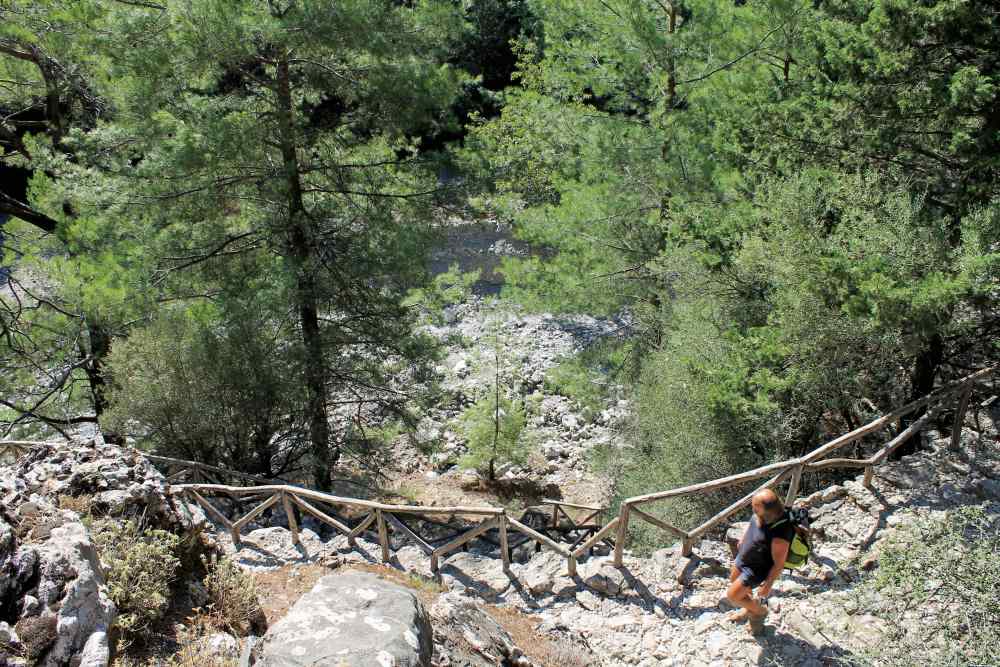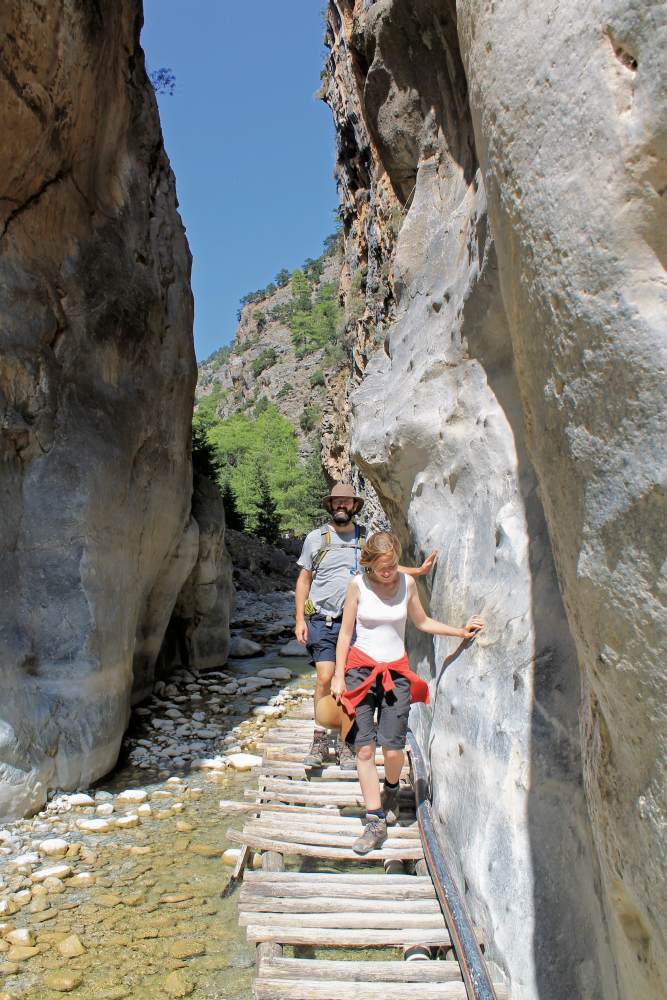- Details
- Written by: Mike Walker
The sky is still semi-dark as I arrive at the top of the Samaria Gorge after a pre-dawn winding bus journey through Crete’s White Mountains. At some 1,227 metres above sea level, Xyloskalo on the Omalos Plateau is the entrance to the Samaria Gorge National Park – and almost as importantly a good place for breakfast.
Cue strong, sweet Greek coffee – the sort that feels gritty between your teeth – and spanakopita cheese and spinach pies as found all over the island.
Suitably braced, and soon after seven in the cool, fresh morning air, I start my descent into the enormous chasm that points a sharp finger from the Mediterranean coast into the heart of this mountainous Greek island.
Ahead of me lies a rocky, rugged descent down to the river bed and a route that will ultimately deposit me 16km from my start point on a beach of black sand with the dazzling blue Libyan Sea stretching out to the horizon.
The route is familiar; it is my fourth sojourn into the gorge and a path I first trod as an innocent and enthusiastic backpacker making my way around Europe in the summer of 1984 with an InterRail pass stuffed into my pocket.
Oddly, I seem to have been lured back at regular intervals since.
Familiar the route may be, but it is one that requires respect. The ground can be harsh underfoot and then suddenly slippery as you put your foot on a smooth, damp stone. This is no place for a disrespectful flip-flop.
In the earlier stages the path, while well-maintained and marked, is steep as it traverses the edge of the rock side; one side against the slope of trees and vegetation, the other protected by a wooden barrier fence that also offers a handrail to the uncertain and unsteady.
Descending under a rising sun
The light, at some unnoticed point, has sharpened with the rising sun and the dull chill of dawn has been replaced by crispness to the morning air.
It is not by chance that the descent starts early. Apart from it being a most beautiful part of the day, it ensures walkers navigate the rugged, more exposed parts of the Samaria Gorge, before the heat of the day bites.
Walking downhill through the cypress and pine trees with the morning sunlight filtered by green branches, is refreshing and exhilarating. The subliminal backdrop is the sound of running water, a rippling melody from a river bed still unseen from this height.
The terrain seems endlessly downward, chewing into knees and calf muscles with every step on the hard ground. Yet it is invigorating too – the antithesis to the idle days of the poolside, the marvellous beaches or the ambience and charm of the Venetian port city of Chania.
As I submerge myself into the gorge, I reflect on the appeal of Crete with its natural diversity, fabulous Mediterranean cuisine, history, culture and shoreline. It is one of the cradles of civilization with the Minoan remains of Knossos one of the island’s must-see sights.
To me, Western Crete always seems a little more relaxed than other parts of the island. The coast is quiet with beaches and small inlets or harbours and there are little gems such as Elafonisi beach with the pinkish hue of the shoreline created by millions of crushed shell fragments, the sandy arc at Falasarna or a boat trip out to Gramvousa Island for snorkelling, swimming and exploring Venetian ruins, and many fabulous restaurants.
A favourite of mine is the small waterside tavern at Sfinari where the speciality at the family-run restaurant is the irresistible Kakavia (fish soup). Crete has some amazing traditional dishes such as beef stifado or souvlaki, stuffed tomatoes and peppers and superb salads, dressed in olive oil produced from the 45 million olive trees dotted across the island – all washed down with good local wine. Forget the clichéd, acquired taste of Retsina, Crete has some fabulous wines and seems to keep the best of them on the island rather than export.
They say the Cretan Mediterranean diet is the healthiest on earth. It’s easy to believe, though their good health might also have something to do with the relaxed pace of life.
While those beaches are a big part of the appeal of western Crete, it is also the diversity the island offers; one day you can be reading a book on a sun bed beneath a parasol and the next, hiking down a deep and challenging gorge.
I allow my mind to meander a little – solo walking down the Samaria Gorge is perfect thinking time, a few hours of contemplation combined with outdoor exercise.
Sturdy walking boots are essential to negotiate the rugged downward path through the trees and there is a sense of relief when it finally levels out onto the river bed with the water flowing close by.

Drinking water ripples out of a fountain too, supplied from the heights of the surrounding White Mountains (Lefka Ori); it is fresh, pure and actually sweet. In fact, the sweetest water I have ever tasted.
I’m now a couple of hours along what is widely-regarded as the longest gorge in Europe and I can feel the rising temperature of the sun. It will take me five hours to walk the whole way. Some will do it in less time and others will take significantly longer. I overtake people on the route, small chatting groups slowed by numbers and conversation, but others armed with poles and pace stride by with a purpose. In the Samaria Gorge, everybody finds their own tempo.
But you always walk with care. No-one wants a twisted ankle and humiliating ride out on the trudging rescue donkeys that sway past from time to time.
Cretans refer to the Samaria Gorge as the “Farangas” or “Great Gorge.” It is an area of outstanding natural beauty and the Samaria National Park on the south-west of the island is rich in plant and animal life with upwards of 450 different species surviving in a delicate ecosystem. While pine and cypress trees abound, the gorge is also home to Crete’s wild goats, kri-kri, which are visible along the route.
You’re certainly free to look around as much as you like as, with signposts along its length, there’s no need for navigation and little danger of getting lost on what is said to be the most-walked path in the whole of Greece – more so even than the Mount Olympus path.
Halfway houses
At about half way, loom the remains of the village of Samaria and the abandoned 14th century church of Ossia Maria, which gives the gorge its name. It was finally abandoned by the last remaining inhabitants in 1962 to make way for the park.
A bridge crosses from the main route of the path to a collection of old houses which still stand. It is a perfect location to rest awhile and eat a light lunch. I pause for a snack of a roll of cold meats and a chocolate bar, brought in my pack as there are no refreshments available on route.
Kri-kri wander among the trees, water spills from fountains which replenish drink bottles and there is welcome shade from the rising heat of late morning.
Setting off again, the gorge takes on a new character over the kilometres ahead; sheer walls soar almost vertically upwards, pressing in closer and closer and channelling the river out to the Libyan Sea. Here, the rugged beauty and scale of the gorge is breathtaking, but there are dangers too.
Signs, to be heeded, warn of falling rocks and loose stones, and the terrain becomes hard underfoot as it follows the river bed. In times of rain, flash floods make these stretches dangerous and impassable and can result in the gorge being closed to visitors. In places, slightly raised platforms take walkers alongside the sheer walls above the water line and bridges criss-cross the flowing river as the route nears a stretch referred to as The Gates. This is the narrowest point where the sides of the gorge close in to a width of only four meters and soar up to a height of almost 300 meters, just short of 1,000 feet.
In places, slightly raised platforms take walkers alongside the sheer walls above the water line and bridges criss-cross the flowing river as the route nears a stretch referred to as The Gates. This is the narrowest point where the sides of the gorge close in to a width of only four meters and soar up to a height of almost 300 meters, just short of 1,000 feet.
Once through, the terrain opens out a little and before long, I arrive at the exit point of the Samaria National Park, after walking for some 13km. It is at this point that you meet walkers heading in the opposite direction, deposited at Agia Roumeli on excursions for the shorter hike to The Gates and back.
However, for those like me, heading down, there is still another 3km on to the shores of the Libyan Sea and the village of Agia Roumeli.
But before long, the coastal settlement falls into view. It is a grid of streets lined with tavernas, small apartments and rooms to let, a few souvenir shops and a promenade that opens out on to the black sandy beach.
There are no roads to and from Agia Roumeli; the options are to walk the 16km back along the gorge, stay overnight or catch the late afternoon boat out to Chora Sfakion (eastbound) or to Sougia and Paleochora (westbound).
It is just after 1pm when I arrive; I take a refreshing dip in the sea and laze a while on the dark sand and then seek the shelter of the taverna and lunch of grilled fish, a Greek salad with feta cheese and olives, and a cool beer as I await the boat for Sougia.
Time passes suitably slowly but hey, I’m in Greece, what’s the hurry?
When the boats come in, I make my choice. I’ve always headed east to Chora Skafion but this time I decide to take the westbound boat to Sougia, past the resort of Loutro which looks pure blue and white Cretan perfection, nestled in a cove. I make a mental note to visit and stay a while on some future visit to Crete.
As the vessel fills with passengers, I settle for the journey to Sougia and the bus back to my room at Maleme just along the coast from Chania with my muscles now beginning to ache after the 16km walk.
On board, the warm sea breeze is reinvigorating but nothing matches the immense satisfaction of conquering this natural fissure in the barren landscape of western Crete. It is a long, long day but you always have the rest of the holiday to relax. After a couple of pool days, ahead of me lies a further hike in the stunning White Mountains.
As the largest of the Greek islands, Crete has so much to offer. In recent years, western Crete has become one of my favourite destinations with rugged scenery reaching down to fabulous beaches, picturesque harbours with shoreline tavernas, small inlets where colourful fishing boats bob on the tide, food and drink that is as good as you will find anywhere, and a warm and welcoming people.
This is what I love about Crete; it can be exactly what you want it to be – hearty exercise, chilled relaxation, fine food and a magical landscape.
Perhaps this is why I keep coming back.




